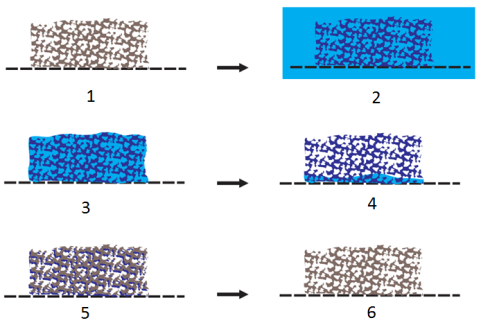As discussed in the previous post, moisture in soil can be measured using different methods. We became familiar with the gravimetric method, volumetric method, and soil-water tension.

Soil, like a sponge, is porous. The holes in soil can be divided into two main groups; some bigger holes (called macro-pores), and some smaller holes (micro-pores). When soil is saturated with water, all the pores are filled with water and there is no room for air in the soil. But if the soil is drained well, soon water drains out of the macro-pores and air takes its place. That is how plant roots can breathe. Most plants and crops die after a few days if their soil is saturated. This is actually how most people kill the beloved plants in their garden; by over-watering them!
 http://www.tankonyvtar.hu/en/tartalom/tamop425/0032_talajtan/ch07s02.html
http://www.tankonyvtar.hu/en/tartalom/tamop425/0032_talajtan/ch07s02.html
Sponge Analogy
A sponge is very similar to a soil profile when it comes to soil-water dynamics. Imagine you put a piece of sponge over a screen or inside a kitchen sieve (Fig. below,1). Now imagine you submerge the sponge and sieve in water. This is going to “saturate” the sponge. Similarly, in a saturated soil, all the pores are filled with water and there is no place for air (Fig. below, 2).

Now take the sieve-sponge out of the water and put it where the sponge can drain freely (Fig. below, 3). The sponge starts to drain water immediately. This is because larger pores (macro-pores) can’t hold water against gravity and water runs out of them by gravitational force. The amount of water that drains out of a saturated soil by gravitational force is called gravitational water.
Let the sponge drain all its gravitational water until it stops dripping (Fig. below, 4). Is the sponge dry now? Obviously not! It still holds significant amounts of water. The force of gravity alone is not enough to drain the sponge dry. This is because micro-pores do not give up water easily. The smaller the pore, the harder it sticks to its water (soil tension). The amount of water that remains in the soil after draining all gravitational water is called the soil’s field capacity. It represents the total amount of water the soil can hold against gravity. So section 4 of the figure below illustrates a sponge in field capacity; or better say sponge capacity!
Field capacity is an important concept in crop-soil-water relationship studies because it gives us an idea of the amount of water a particular soil can hold. This is a very important parameter in irrigation practices.
Okay, let’s see what happens to our sponge next – it keeps drying due to evaporation. As it dries out, more pores lose their water. Smaller pores always lose their water later; because as mentioned, they hold onto water with greater force. The reason goes back to water physical properties. You may have not noticed, but water is actually a very “sticky” and “thick” liquid relatively; especially at the molecular level. Therefore, it is harder to extract water out of smaller pores compared to larger pores.
Available Water
Let’s repeat the sponge experiment with a flower pot.
Saturation: Put the flower pot in a bucket of water until the soil is completely saturated with water. Note that if saturation condition continues, the flower will die.
Gravitational Water Drains: Take the flower pot out of the water bucket. It immediately will start draining water.
Field Capacity: Once the flower pot stops dripping water, the soil is at field capacity. In this situation its holding its maximum available water. The plants now can uptake water easily. Readily available water is the portion of available water that is easily accessible to plants.
 As water is depleted from soil profile, the remaining water holds tighter to soil particles and therefore it is more difficult for plants to extract water from the soil. Then it comes to the point that the plant can no longer extract water from the soil (Permanent Wilting Point). Soil at the Permanent Wilting Point is not completely dry, as it still has a little bit of water; but the amount is so little it is not accessible by plants. It is like squeezing a wet cloth to the point that it does not drip water anymore; no matter how hard you squeeze it, you can feel it is still wet.
As water is depleted from soil profile, the remaining water holds tighter to soil particles and therefore it is more difficult for plants to extract water from the soil. Then it comes to the point that the plant can no longer extract water from the soil (Permanent Wilting Point). Soil at the Permanent Wilting Point is not completely dry, as it still has a little bit of water; but the amount is so little it is not accessible by plants. It is like squeezing a wet cloth to the point that it does not drip water anymore; no matter how hard you squeeze it, you can feel it is still wet.

